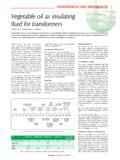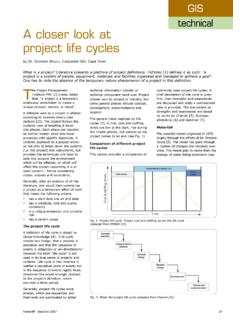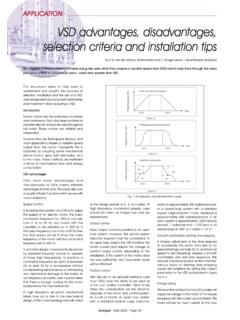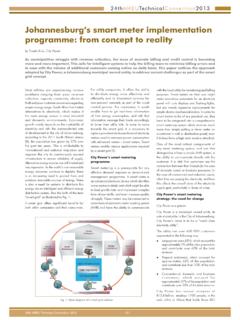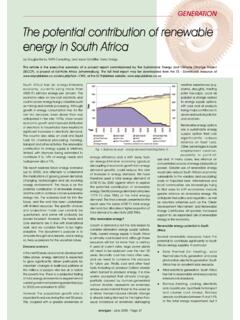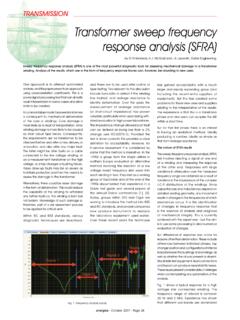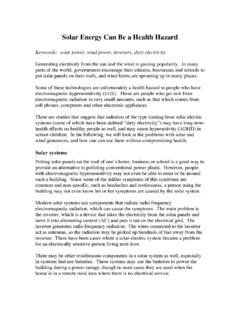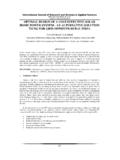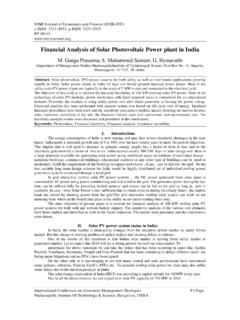Transcription of SUSTAINABLE ENERGY Off-grid electrifi cation in rural areas ...
1 SUSTAINABLE ENERGY . Off-grid electrification in rural areas of South Africa by Steve White and Stephen Koopman, Eskom South Africa is committed to providing access to electricity to all by 2012. grid electricity is the general approach and around 70% of households are already connected. However, of the remaining 30% that still need to be electrified, 51% of these lie in the deep rural areas of South Africa. This coupled with the rising costs of material and the ever increasing costs of electricity makes grid electrification more and more uneconomical. Eskom, at the present time also has capacity constraints to contend with. These days the global thinking is moving towards using renewable technologies to produce ENERGY . This coupled with the call to reduce carbon emissions makes off grid electrification more attractive. With newer technologies coming to the fore on a daily basis as well as photo voltaic products becoming less expensive, the answer seems to lie with off grid applications to supply the basic electricity needs for extreme rural households.
2 Harnessing solar power is not a modern concept, the ancient Egyptians used the Fig. 1: Solar radiation for 2007. sun for heating more than two thousand years ago. They positioned their houses in such a way as to get maximum light and heat from the sun. In the past, renewable ENERGY concepts were seen as a luxury, rather than a necessity. This was due mainly because of the cost involved in developing them. Today however, because of our constraints with being able to meet capacity, renewable ENERGY ideas are becoming more attractive. For the extreme rural homes, the cost of grid electrification is so prohibitive that it becomes almost impossible. According to SESSA ( SUSTAINABLE ENERGY Society of Southern Africa ) calculations show that Fig. 2: Solar radiation for 2008. living more than 5 km from the National grid , PV becomes viable because of reticulation costs. Considerations for Off-grid electrification There are a number of issues that come to mind when considering Off-grid electrification, namely: Environmental issues The obvious environmental issues that come to mind, especially in the deep rural areas , is the impact on pollution.
3 Less wood burning less pollution as well as Fig. 3: Solar radiation for 2009. preserving forests. Residents on average in rural electrified homes 81% collect their own the need to be as carbon efficient as non- electrified areas spend more money firewood. This is an obvious environmental possible. These days it is fast becoming on fuel than people living in electrified homes. According to [2] Electrification issue, when it comes to preserving our evident that large corporations will first Statistics published by The Department trees. According to the report, people in look at a company's carbon footprint of ENERGY (DoE) for lighting alone 78% of non electrified areas spend about 3 to 4 before deciding on buying a product. non electrified homes spend money on times more money on ENERGY than people Furthermore, using renewable ENERGY candles against only 3% for electrified in electrified areas . can help reduce carbon emissions and homes.
4 There is also a significant difference therefore helping our environment. rural Carbon footprint between them when it comes to the use households using solar ENERGY , benefit of firewood. 48% against 70%. Of the non In South Africa, companies are recognizing from a subsidy from the government of energize - September 2011 - Page 68. SUSTAINABLE ENERGY . South Africa Overall cost per connection rural connections Urban connections in developing this new technology. 1991/94 R3176 572 441 66 853 Case study 1. 1995 R3370 226 065 87 114 Photovoltaic production has been doubling 1996 R3417 261 438 45 609 every two years, increasing by an average 1997 R3159 24 188 43 662. of 48% each year since 2002, making it the world's fastest growing technology. In 1998 R3008 19 819 93 155 South Africa one of the company's that use 1999 R2899 173 625 125 622 PV technology is NuRa. 200 R2647 133 672 122 351 NuRa was established in 1999.
5 They were 2001 R2532 105 587 103 948 awarded a government concession that 2002 R2614 107 718 103 910. covers in the region of 10 000 km . In 2003. NuRa conducted and extensive customer 2003 R3384 117 108 58 288 survey [5] to test the feasibility of using a 2004 R4207 126 477 43 893 solar home system (SHS) for electrification. 2005/6 R4137 119 077 16 791 Within that survey it was shown that the 73% of the average income was below 2006/7 R6732 139 634 12 491. R2000 per month of which they spent an 2007/ R7293 34 959 133 579 average of 10% of their income on ENERGY 2008/9 R12 073 90 523 22 442 such as gas, candles etc. From the survey it was found that of the customers that were 2009/1 R12 435 115 734 34 167. using the SHS 99% of them stated that the Table 1: Average costs per connection. system was easy to use and 82% of them said that it worked very well. South Africa is around 225 W/m compared Of the sample that were using the system R40 per month.
6 One 50 W panel equates to Europe where the average is around 80% of them used a black and white TV, to approximately 250 Wh/day. 100 W/m . as the solar system supported the use Safety issues of this type. The rest of the household Cost appliances used gas as their primar y The health and safety risks associated source of ENERGY . Within the area NuRa with the use of paraffin and candles as At present PV is approximately four times have also strategically placed ENERGY well as the use of wood has been well the cost of coal electrical generation. stores that carry spares for the PV panels documented. They not only present a fire The capital cost of a solar installation as well as alternative fuel supplies such hazard to the community but also present compares ver y favourably with grid as Liquid Petroleum Gas (LPG), this takes a huge health risks to the occupants, electrification. According to NuRa the care of the communities cooking medium.
7 Arising from the pollution by using these capital cost per household for solar in These stores now act as a One Stop shop methods of lighting, heating and cooking. 2006 was around R4000 compared to that for all the local customers ENERGY needs. of grid electrification which was between Moral obligations R6000 and R7000. These costs have risen The unique factor with the SHS is the fact quite dramatically in the last couple of that it is not dependant on the structure of It is in the interest of the government of years to an alarming overall average of the dwelling. When the survey was carried South Africa to electrify all to uplift the around R12 000 per connection. Obviously out, only around 60% of the dwellings people and to make life for the poorer the cost of reticulation as mentioned is were in fact Permanent houses made areas of South Africa that little bit easier. extremely high for rural areas because from bricks and mortar.
8 The rest were transmission lines in most cases do not exist, made up from permanent shacks 20%. Optimal angle of PV panels also the population density for deep rural (corrugated iron and brick mixture as There are maps that exist of the nominal communities makes grid electrification well as 14% were made from traditional angle that PV panels should be set at extremely uneconomical. The utility for materials such as mud thatch etc. Of the depending on location in South Africa grid connections obtain a subsidy from potential customers interviewed close to as well as amount of average radiation the government to the amount of R4000, 90% of them used candles for lighting, so expected from a particular location. The whereas the utility supplying off grid power as far as a safety aspect the improvement general consensus in South Africa is that receives a subsidy of R3500. The average is there to be seen. the nominal angle of PV panels should be cost per connection of solar home systems between 30 and 40.)
9 Figs. 1 to 3 show in 2006 according to Rob Costermans [3] To date NuRa have installed around the average watts per square meter that was between R3500 and R4000. 1 0500 installations in the deep rural areas South Africa receives from solar radiation. of northern Kwazulu Natal. The installation Table 1 shows the significant rise in average consists of a PV panel with an inverter and As can be seen by the graphs, South Africa cost per connection over the last few deep cycle batteries. This is enough to is one of the top country's in the world years. As can be seen from Fig 4., the power up some compact fluorescent lights when it comes to solar radiation. The fact majority of outstanding electrification as well as a black and white television set that even in winter, South Africa only loses projects lie in rural areas of South Africa, and a cell phone charger. The program around 200 W/m 2 compared to summer. coupled with high cost of electrification has been extremely successful and is South Africa also only loses on average because of locality.
10 Based on a fee for service model. This an hour of sunlight in the morning and an eliminates a capital cost to the customer, hour in the evening during winter. It must Thin film technology which is a predominately poor area. The be pointed out that this data is collected With the advent of thin film technology in local reaction to Off-grid electrification on from the Johannesburg area, therefore the the solar panel arena, the call is to reduce the whole has been quite favourable, as profile will obviously differ for other parts of the cost of manufacture to at least the they realize that grid electrification is many South Africa. What is clearly evident from equivalent of $ 1/W this will then make years away, if at all. During the survey the these graphs, is the fact that South Africa is the project attractive to the consumer as customers were asked when to expect grid such an ideal place for using the sun to its well as being more aesthetically pleasing.
